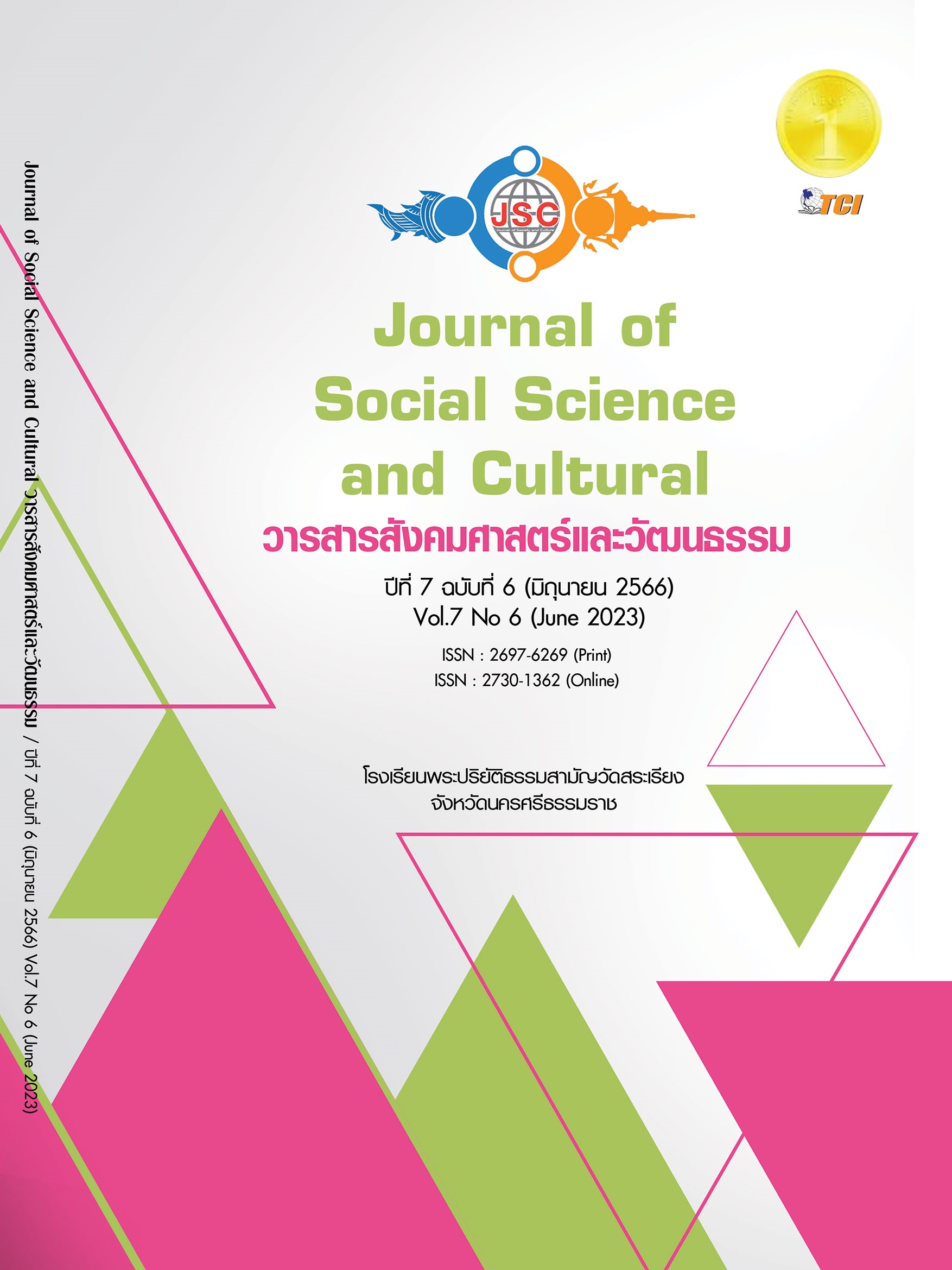HEALTH COMMUNICATION VIA SOCIAL MEDIA TO REDUCE SUGAR CONSUMPTION IN THE PREVENTION OF NCDs AMONG WORKING WOMEN
Main Article Content
Abstract
The purpose of this research was to study health communication via social media to reduce sugar consumption in the prevention of noncommunicable diseases (NCDs) among working women in issues related to 1) communication policy, 2) content design, 3) presentation and dissemination, 4) communication strategies, and 5) communication development approaches. This qualitative research employed in-depth interviews involving 24 key informants who were health communication management personnel, medical professionals, working women, and communications arts academics. The research tool was a structured in-depth interview form. The data were analyzed descriptively. The significant findings were: 1) Communication policy: The principle of Tri-Power should be applied to lay out the communication policy framework. Communication goals should be clearly defined in accordance with the individual, social, and policy levels. 2) Content design: Issues in designing health message content must be identified conforming to working women's concerns, demands, and lifestyles. Determination of tone and manners and the use of feminine language in communication in an easy-to-understand fashion are crucial. Emphasis is placed on the use of symbols and colors to facilitate recognition. 3) Presentation and dissemination: the presentation is geared toward storytelling techniques that keep up with trends, suitable for social media channels. Disseminated by tailoring the time frame and frequency to align with the content and target audiences. 4) Communication strategies: the strategic formulation includes persuasive strategies, emotional appeal strategies, empowerment strategies, modeling strategies, and networking strategies. 5) Communication development approaches: a working team should be established to drive comprehensive communication plans that are closely engaged with network partners, along with the cultivation of female role models of communication within organizations and communities, to expand the work of health communication via social media to reduce sugar consumption in the prevention of NCDs as guidelines for other health promotion agencies to apply at national and local levels.
Article Details
References
กมล ไชยสิทธิ์ และคณะ. (2565). นโยบายและแนวทางการดำเนินการการสื่อสารสุขภาพด้วยสื่อสังคมออนไลน์ของสถาบันมะเร็งแห่งชาติเกี่ยวกับโภชนาการในการป้องกันโรคมะเร็งในพนักงานสำนักงาน. วารสารสังคมศาสตร์และมานุษยวิทยาเชิงพุทธ, 7(12), 187-201.
กรมอนามัย. (2561). น้ำตาลทานเท่าไหร่? เรียกใช้เมื่อ 28 ธันวาคม 2563 จาก https://multimedia.anamai.moph. go.th/video-knowledges/daily-sugar-intake/
แคทรียา การาม และคณะ. (2564). รูปแบบการขับเคลื่อนนโยบายสาธารณะเพื่อสุขภาพแบบมีส่วนร่วมในระดับพื้นที่สู่การปฏิบัติจังหวัดนนทบุรี ปี 2559. วารสารสหศาสตร์, 21(2), 144-161.
ณัฐชยา นาคำ และคณะ. (2563). ผลของโปรแกรมการเรียนรู้แบบมีส่วนร่วมสำหรับแกนนำนักเรียนต่อความรู้และการปฏิบัติการจัดการอาหารในโรงเรียน. เชียงใหม่เวชสาร, 60(1), 114-24.
ตรีชฎา หวังพิทักษ์. (2562). การสื่อสารการสร้างเสริมสุขภาวะของเว็บไชต์ไทยเฮลท์ในสื่อสังคมออนไลน์กับการเปิดรับและการใช้ประโยชน์ของเยาวชนในกรุงเทพมหานคร. เรียกใช้เมื่อ 28 ธันวาคม 2563 จาก libdoc.dpu.ac.th/thesis/Treechada.Wan.pdf
ธิติพัทธ์ ลิ้มสัมฤทธิ์นิภา และจันทิมา เขียวแก้ว. (2564). รูปแบบการสื่อสารเพื่อสร้างคุณค่าตราองค์กรของสถาบันอุดมศึกษาตามแนวคิดพันธกิจสัมพันธ์. วารสารสังคมศาสตร์และมานุษยวิทยาเชิงพุทธ, 6(4), 96-110.
ผู้ให้ข้อมูลสำคัญคนที่ 1. (22 กันยายน 2565). การสื่อสารสุขภาพทางสื่อสังคมออนไลน์เพื่อลดการบริโภคน้ำตาลในการป้องกันโรคไม่ติดต่อเรื้อรัง ในกลุ่มสตรีวัยทำงาน. (กนกพงษ์ ม่วงศรี, ผู้สัมภาษณ์)
ผู้ให้ข้อมูลสำคัญคนที่ 2. (16 กันยายน 2565). การสื่อสารสุขภาพทางสื่อสังคมออนไลน์เพื่อลดการบริโภคน้ำตาลในการป้องกันโรคไม่ติดต่อเรื้อรัง ในกลุ่มสตรีวัยทำงาน. (กนกพงษ์ ม่วงศรี, ผู้สัมภาษณ์)
ผู้ให้ข้อมูลสำคัญคนที่ 3. (9 กันยายน 2565). การสื่อสารสุขภาพทางสื่อสังคมออนไลน์เพื่อลดการบริโภคน้ำตาลในการป้องกันโรคไม่ติดต่อเรื้อรัง ในกลุ่มสตรีวัยทำงาน. (กนกพงษ์ ม่วงศรี, ผู้สัมภาษณ์)
ผู้ให้ข้อมูลสำคัญคนที่ 4. (16 กันยายน 2565). การสื่อสารสุขภาพทางสื่อสังคมออนไลน์เพื่อลดการบริโภคน้ำตาลในการป้องกันโรคไม่ติดต่อเรื้อรัง ในกลุ่มสตรีวัยทำงาน. (กนกพงษ์ ม่วงศรี, ผู้สัมภาษณ์)
ผู้ให้ข้อมูลสำคัญคนที่ 5. (7 กันยายน 2565). การสื่อสารสุขภาพทางสื่อสังคมออนไลน์เพื่อลดการบริโภคน้ำตาลในการป้องกันโรคไม่ติดต่อเรื้อรัง ในกลุ่มสตรีวัยทำงาน. (กนกพงษ์ ม่วงศรี, ผู้สัมภาษณ์)
เยาวนารถ พันธุ์เพ็ง และกัญญรัตน์ หงส์วรนันท์. (2563). การสื่อสารสุขภาพผ่านสื่อสังคมเครือข่ายกับกลุ่มโรค NCDs ตามแนวคิด “สร้างนำซ่อม”. วารสารสหศาสตร์ศรีปทุม, 6(1), 56-67.
รินรดา มะอาลา และคณะ. (2564). การประชาสัมพันธ์ด้วยสื่อสังคมออนไลน์ของเทศบาลนครหาดใหญ่จังหวัดสงขลา. วารสารการบริหารการปกครองและนวัตกรรมท้องถิ่น, 5(1), 299-314.
วสุนธรา รตโนภาส. (2560). กินดีสาหรับสุขภาพดีในศตวรรษที่ 21. The Golden Teak: Science and Technology Journal, 4(1), 1-14.
วีระศักดิ์ พุทธาศรี. (2561). สามเหลี่ยมเขื้อนภูเขา: 9 ปีสมัชชาสุขภาพแห่งชาติของประเทศไทย (พ.ศ. 2551-2559). นนทบุรี: สำนักงานคณะกรรมการสุขภาพแห่งชาติ.
ศศิธร นะราวัง และสุพัฒน์ อาสนะ. (2562). ปัจจัยที่มีความสัมพันธ์กับพฤติกรรมการใช้เครือข่ายสังคมออนไลน์ของนักศึกษาวิทยาลัยการสาธารณสุขสิรินธร จังหวัดขอนแก่น. วารสารวิทยาศาสตร์สุขภาพและการสาธารณสุขชุมชน, 23(1), 1-16.
สรรค์ชัย โพธิสุวรรณ. (2563). การวิจัยและพัฒนาเครือข่ายเยาวชนเพื่อป้องกันการกระทำผิดและตกเป็นเหยื่ออาชญากรรมด้วยกระบวนการสื่อสังคมออนไลน์. วารสารวิชาการคณะมนุษยศาสตร์และสังคมศาสตร์, 11(1), 1-14.
สำนักงานสถิติแห่งชาติ. (2560). การสำรวจพฤติกรรมการบริโภคอาหารของประชากร พ.ศ. 2560. เรียกใช้เมื่อ 28 ธันวาคม 2563 จาก www.nso.go.th/sites/2014/DocLib13/ด้นสังคม/ลาขาสุขภาพ/Food_consumption_behavior_of the_population/2560/รายงานฉบับสมบูรณ์.pdf
สำนักโรคไม่ติดต่อ. (2560). แผนยุทธศาสตร์การป้องกันและควบคุมโรคไม่ติดต่อระดับชาติ 5 ปี (พ.ศ. 2560 - 2564). เรียกใช้เมื่อ 28 ธันวาคม 2563 จาก https://www.thaincd.com/document/doc/plan/หนังสือ_แผนยุทธศาสตร์NCDระดับชาติ.pdf
สุภาพร นิภานนท์. (2560). กลยุทธ์การสื่อสารและการบริหารประเด็นเพื่อผลักดันนโยบายระบบสุขภาพมาตรฐานเดี่ยว. นิเทศสยามปริทัศน์, 16(21), 157-69.
เสริมพันธุ์ ศรีจันทร์ และคณะ. (2565). พฤติกรรมการดูแลสุขภาพของประชาชนวัยทำงานในเขตเทศบาลเมืองฉะเชิงเทรา. วารสารวิชาการศิลปศาสตร์ประยุกต์, 15(1), 1-15.
อัจฉรา ฉัตรเฉลิมพล และคณะ. (2561). ผลของสื่อสังคมออนไลน์ต่อองค์กรและการรับรู้ของลูกค้ากรณีศึกษา บริษัท ปตท. จำกัด(มหาชน)(ปตท). วารสารมนุษยศาสตร์และสังคมศาสตร์ มหาวิทยาลัยราชภัฏสุรินทร์, 20(1), 1-14.
อิริยาพร อุดทา และอริชัย อรรคอุดม. (2560). กลยุทธ์การสื่อสารสุขภาพออนไลน์ผ่านสื่อเฟซบุ๊กของโรงพยาบาลพญาไท. วารสารครุศาสตร์อุตสาหกรรม มหาวิทยาลัยเทคโนโลยีราชมงคลธัญบุรี, 5(2), 145-156.
Bidmon, S. & Terlutter, R. (2015). Gender Differences in Searching for Health Information on the Internet and the Virtual Patient-Physician Relationship in Germany: Exploratory Results on How Men and Women Differ and Why. Journal of medical Internet research, 17(6), e156.
Butterworth, S. E. et al. (2019). Sender gender influences emoji interpretation in text messages. Frontiers in Psychology, 10(784), 1-5.
Fried, S.K. & Rao, S. P. (2003). Sugars, hypertriglyceridemia, and cardiovascular disease. The American journal of clinical nutrition, 78(4):873S-880S.
Hallam, J. et al. (2016). Gender-related Differences in Food Craving and Obesity. Yale J Biol Med, 89(2). 161-73.
Khumhome, B. et al. (2021). Marketing strategies for safe food market in Ubon Ratchathani Province. Journal of Roi Kaensarn Academi, 7(4), 174-89.
Massey, P. M. et al. (2021). Development of personas to communicate narrative-based information about the HPV vaccine on twitter. Frontier Digital Health, 3.


